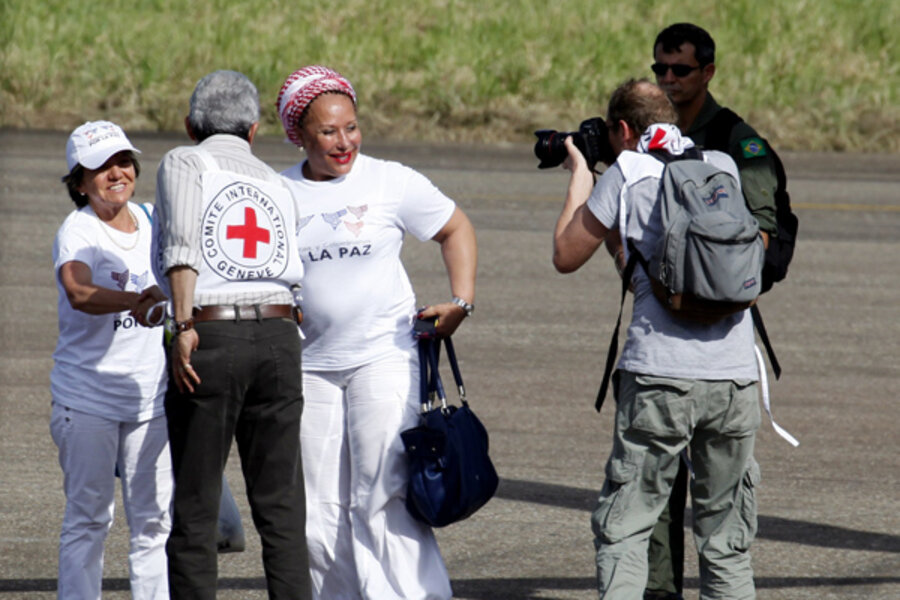FARC hostage release raises hopes for Colombia peace talks
Loading...
| Bogota
Colombia’s largest rebel group is due to begin releasing the last of its government hostages today, in what is being heralded as a first step toward possible peace talks, though analysts warn negotiations are unlikely to begin any time soon.
The Revolutionary Armed Forces of Colombia (FARC) said it would release ten members of Colombia’s security forces, some of whom have been held for as many as 14 years, in a two-stage process that will begin today and conclude on Wednesday.
Families of the hostages gathered in the city of Villavicencio in Meta province yesterday, and the government prepared for the departure of two Brazilian helicopters that will set out with Piedad Cordoba, a former Colombian senator who has acted as facilitator in recent hostage releases. They will retrieve the men at an undisclosed site in the jungles of Colombia today, and the government agreed to cease military operations in the general area of the releases.
The 10 men, whom the FARC calls “prisoners of war,” are the last remaining “swappable” hostages that the rebels once hoped to exchange for jailed FARC members. Nearly all were captured during FARC attacks on military bases and police stations in the late 1990s. The FARC announced the impending release in a February communiqué in which they also announced a ban on future kidnappings for ransom.
Voices of kidnapping
Every Saturday at midnight until 6 a.m. on Sunday, Caracol Radio airs a program called “Voices of Kidnapping” where relatives of hostages read out messages of hope and strength to their loved ones. The program has become such an institution that hostage keepers allow their captives to listen.
At 1 a.m. on Sunday, teenager Jonathan Salcedo sent his last message to his father Robinson Salcedo, who was kidnapped when Jonathan was four years old. “I have memories of my father and I have been waiting 14 years to hug him. Hopefully on Monday I will,” he said on the program.
The FARC has not announced which of the hostages will be released on Monday and which on Wednesday. As the moment for the release approaches speculation has grown that all 10 could be freed at the same time.
Furthermore, the FARC hasn’t indicated whether its new ban on kidnapping for extortion means it plans to release the civilian hostages it abducted for ransom. Figures on how many civilian hostages are currently held are unclear, partly because many cases are not reported. If abductions are reported, in many cases the release of a civilian hostage is not.
Consuelo Cordon’s two brothers and a brother-in-law were kidnapped in 2003 in three separate abductions. “Keep your spirits up,” she told them on the radio program Sunday. She congratulated the men who are to be released this week but asked Colombians not to forget about “all the civilian hostages.”
'Wishful thinking'
Ms. Cordoba, the former senator acting as facilitator for this week’s hostage release, said the releases are a unilateral "gesture of peace" by the FARC that should lead to peace negotiations with the government.
But Michael Shifter, president of the Washington-based think tank Inter-American Dialogue, said there was a “measure of wishful thinking” among those who see this as a first step toward peace talks, adding that there is still a “long way to go” before the FARC and the government are ready to sit down at opposite sides of a negotiations table. The last attempt at negotiating an end to the internal conflict collapsed in 2002 when the FARC highjacked a domestic flight and kidnapped a senator among the passengers.
At the time, the FARC was at its pinnacle of strength, with anywhere between 18,000 and 20,000 fighters. The rebels used ransom payments to fund their fight against the state, and used political hostages to put pressure on the government. Among the political hostages were French-Colombian politician Ingrid Betancourt and three American military contractors who were rescued in 2008 in a military intelligence operation.
Today, after a sustained military counterinsurgency campaign backed by more than $7 billion in mostly military aid from the United States, the FARC's ranks have been halved to an estimated 9,200 fighters, according to intelligence sources.
In the last two weeks of March, the military attacked two FARC rebel camps in the eastern plains killing more than 60 rebels. In a second bomb attack, in Vistahermosa on March 26, six rebel commanders were killed in what Defense Minister Juan Carlos Pinzon called a “substantial and permanent blow” to the FARC.
The recent operations are part of a new government strategy against the rebels that is targeting mid-level operational commanders rather than the top leadership. The FARC has lost six of its most senior leaders since 2008. The current leader Rodrigo Londoño, also known under the nom de guerre Timoleón Jiménez or Timochenko, took over the top post in November. While rebel attacks have increased under his command, he has simultaneously called on the government to begin peace talks.
“The FARC is trying to enhance [its] legitimacy but they are doing it from a weakened position,” says Mr. Shifter. “The government is being extremely careful in not giving in to the enormous temptation to pursue peace because of the skepticism in the ruling coalition.”
“It’s a dance we see a lot of in Colombia,” says Shifter.





